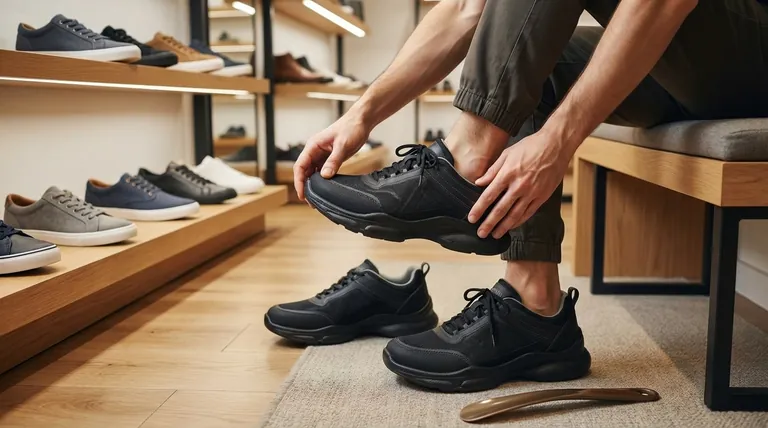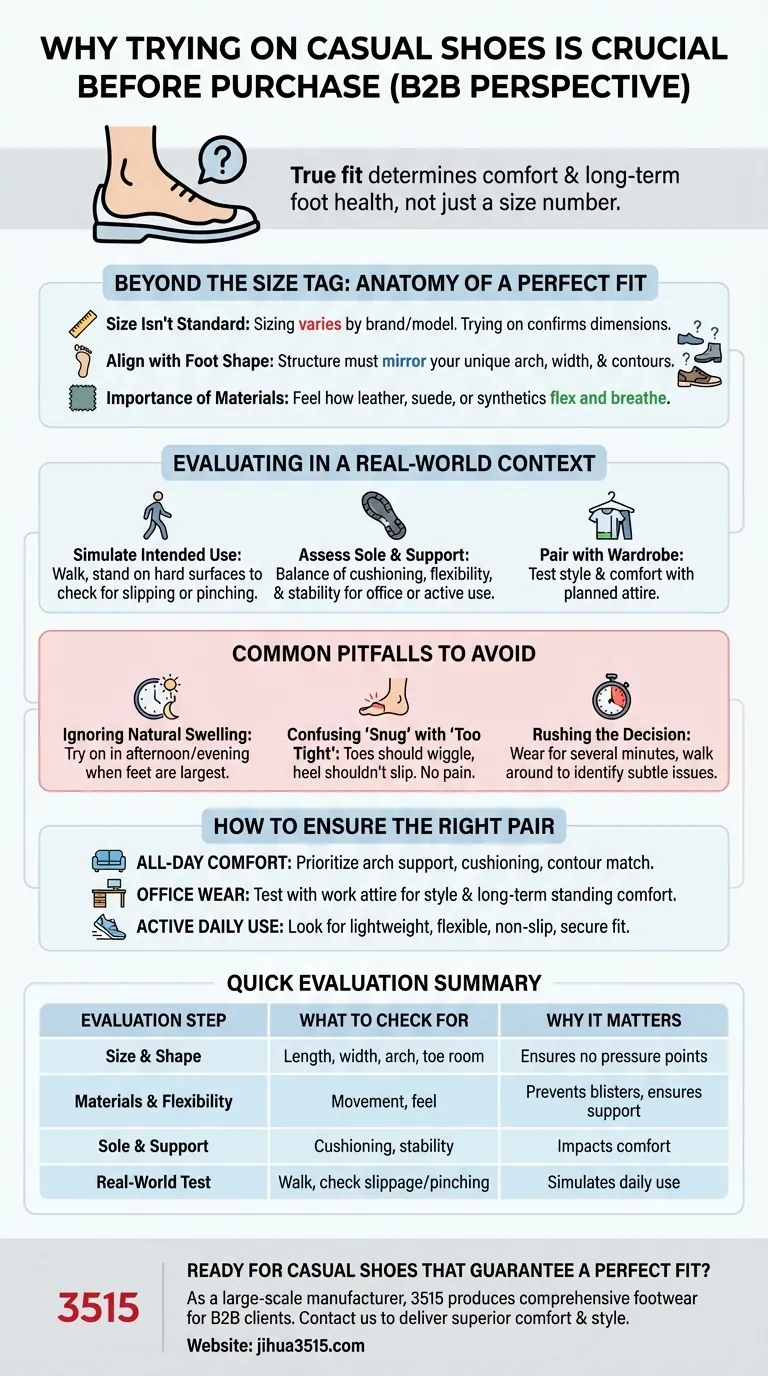Trying on casual shoes is the single most important step before a purchase because a size number is merely a suggestion. The true fit is determined by how a shoe’s specific shape, materials, and construction conform to your unique foot, directly impacting your comfort and long-term foot health.
Beyond simply confirming a size, trying on a shoe is a critical diagnostic test. It allows you to assess how its structure supports your foot during real-world movement, ensuring the investment provides genuine comfort and value.

Beyond the Size Tag: The Anatomy of a Perfect Fit
A shoe that fits poorly is more than an inconvenience; it can cause chronic issues. The try-on phase is your opportunity to evaluate the shoe’s fundamental compatibility with your body.
Why Size Isn't a Standard
Shoe sizing is notoriously inconsistent across different brands and even different models from the same brand. A "size 10" can vary significantly in length and width.
Relying on the number alone is a gamble. Trying the shoe on is the only way to confirm it matches your foot's actual dimensions.
Aligning with Your Foot Shape
Every foot is different, with unique arch heights, widths, and contours. A good fit means the shoe’s structure mirrors your foot’s natural shape.
This alignment provides proper support, prevents painful pressure points, and enhances comfort during prolonged wear.
The Importance of Materials
The materials—be it leather, suede, or synthetic fabrics—dictate how the shoe flexes, breathes, and adapts to your foot over time.
Trying a shoe on allows you to feel how the material moves with your foot. Stiff materials might cause blisters, while overly soft ones may lack necessary support.
Evaluating the Shoe in a Real-World Context
A shoe might feel fine when you’re sitting down, but its true performance is revealed when you simulate its intended use. This is a crucial part of the evaluation.
Simulating Your Intended Use
Are these shoes for walking around town or for standing in an office? The demands are different.
Walk around the room, preferably on a hard surface. Feel for any slipping in the heel, pinching in the toes, or inadequate arch support. This simple test reveals how the shoe will perform in daily life.
Assessing the Sole and Support
The sole is the foundation of the shoe. It should provide a balance of cushioning, flexibility, and stability.
For active use, look for flexible, non-slip soles. For office wear, ensure the sole is supportive enough for a full day of standing or walking on hard floors.
Pairing with Your Wardrobe
As the references note, it's wise to try on shoes with the type of clothing you plan to wear them with.
This step helps you assess not only the comfort but also the style. It ensures the shoe complements your wardrobe and sends the intended message, whether casual or professional.
Common Pitfalls to Avoid
Making a hasty decision during the try-on process can lead to regret. Being aware of common mistakes ensures you gather the most accurate information.
Ignoring Your Foot's Natural Swelling
Feet naturally swell slightly throughout the day. Trying on shoes in the morning can give you a misleading sense of fit.
For the most accurate assessment, it is best to try on shoes in the afternoon or evening when your feet are at their largest.
Confusing "Snug" with "Too Tight"
A new shoe, especially one made of leather, should feel snug but not painful. There's a critical difference between a firm, supportive fit and one that pinches or cramps your toes.
Your toes should have room to wiggle, and your heel should not slip excessively. Any sharp or painful pressure points are a red flag.
Rushing the Decision
Don't just slip the shoe on and off. Wear both shoes for several minutes and walk around as much as possible.
This extended test gives your feet time to settle into the shoes and helps you identify subtle comfort issues that aren't apparent in the first 30 seconds.
How to Ensure Your Next Pair is the Right Pair
Your goal dictates which factors to prioritize. Use this framework to make a definitive choice.
- If your primary focus is all-day comfort: Prioritize models with excellent arch support, cushioned soles, and a shape that perfectly matches your foot's contours.
- If your primary focus is office wear: Test the shoes with your work attire for both style and the ability to remain comfortable through a full day of mixed sitting and standing.
- If your primary focus is active daily use: Look for lightweight materials, a flexible and non-slip sole, and a secure fit that prevents your foot from sliding inside the shoe during movement.
By treating the try-on process as a non-negotiable quality check, you empower yourself to invest in footwear that truly serves you.
Summary Table:
| Evaluation Step | What to Check For | Why It Matters |
|---|---|---|
| Size & Shape | Length, width, arch alignment, toe room. | Sizing varies by brand; ensures no pressure points. |
| Materials & Flexibility | How materials move and feel with your foot. | Prevents blisters; ensures proper support and breathability. |
| Sole & Support | Cushioning, flexibility, stability on hard surfaces. | Impacts comfort during walking or standing all day. |
| Real-World Test | Walk around; check for heel slippage or pinching. | Simulates daily use to reveal long-term comfort issues. |
Ready for Casual Shoes That Guarantee a Perfect Fit?
As a large-scale manufacturer, 3515 produces a comprehensive range of footwear for distributors, brand owners, and bulk clients. Our production capabilities encompass all types of shoes and boots, ensuring you get the precise fit, quality materials, and durable construction your customers demand.
Let us help you deliver superior comfort and style. Contact us today to discuss your footwear needs!
Visual Guide

Related Products
- Wholesale Breathable Training Shoes Custom Athletic Footwear Manufacturer
- Wholesale Durable & Breathable Training Shoes for Custom Brands
- Lightweight Breathable Training Shoes for Wholesale & Custom OEM Manufacturing
- Wholesale Lightweight Cushioned Athletic Sneakers for Custom Bulk Production
- Wholesale Breathable & Cushioned Training Shoes Custom Factory Production
People Also Ask
- How do athletic shoes with non-slip features differ from regular ones? Discover the Grip Advantage
- What should be considered when choosing smart trainers for business casual? A Guide to Professional Style
- What are the benefits of athletic-style work shoes? Boost Comfort and Safety for Your Team
- What are the benefits of breathable materials in work shoes? Enhance Comfort & Health for Your Workforce
- Why are running shoes and walking shoes not interchangeable? Avoid Injury with the Right Footwear



















